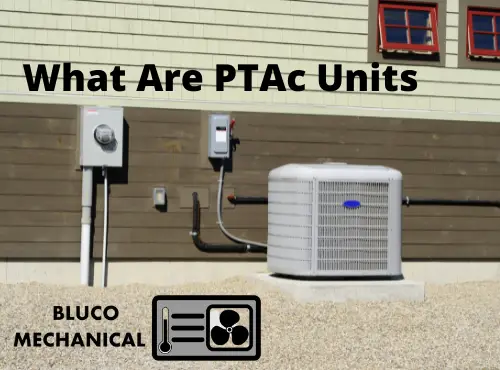Bluco mechanical is an expert in PTAC units in NYC. For more information, you can call (929) 447-2077.
A packaged terminal air conditioner, or PTAC, is a ductless, self-contained air conditioning unit capable of heating and cooling tiny spaces. They are most frequently spotted beneath the windows of numerous hotels and motels throughout the country. PTACs are utilized to reduce expenses and promote energy efficiency in various settings, including hotels, hospitals, senior living facilities, flats, and home additions such as sunrooms.
PTACs come in electric heat or reverse cycle heat pump configurations. While the dimensions of a PTAC are standard at 42×16 inches, 36×15 inches, and 40×15 inches, they are available in four different cooling capabilities ranging from 7,000 to 17,000 BTUs.
How PTAC Units Works
What are PTAC units? How it works, PTACs are capable of both heating and cooling. PTACs employ either common refrigerant or fresh air input to chill the air. PTAC systems have an evaporator coil facing the room to be cooled and a condenser coil facing the outside.
Utilizing a new air intake system is like opening a window. The PTAC draws air directly from the outside via a back vent. Some versions include an integrated dehumidifier that eliminates moisture from the outside air.
However, the most typical approach is circulating internal air using a refrigerant, which is also the most efficient method. The refrigerant cools the coil, which in turn removes the air’s heat and humidity. To regulate the air temperature in a PTAC unit, you can use either the controls on the PTAC or a wall thermostat. A wall thermostat enables the installation of a programmable controller equipped with an energy management system and even Wi-Fi connectivity.
Energy management systems can be as straightforward as “smart” thermostats such as Nest or as complex as an entire innovative home system capable of controlling lighting, climate, appliances, and electronics. These systems are intended to maximize energy efficiency and communicate with the power grid.
It involves hot wires and a fan blowing air across them — similar to a blow dryer. While many PTACs operate solely on resistive electric heat, some incorporate a reverse cycle heat pump.
A heat pump operates in the same way as a window unit air conditioner but reverse. It uses a valve to control the flow of freon in the unit to blow hot air into the building and cold air out the back. Heat pumps consume between 25% and 75% less energy than other types of electric heat.
What Distinguishes a PTAC From a Window Units
A PTAC is more efficient and has commercial components than a window unit. A window unit is installed outside a wall and features vents on the casing’s side. While a PTAC has solid sides, it cools the outer coil by sucking air in via the side vents. Additionally, a PTAC is flush with the wall, leaving only the grill visible from the outside. Additionally, the majority of window units lack heat. You can look for ptac units near me.
Savings on Costs
PTACs help you save money on your utility bills by managing the climate in only the rooms that require heating or cooling. In a commercial application such as a hotel or hospital, a massive heating and cooling system that maintains the climate throughout the facility is prohibitively expensive due to its constant operation.
Each PTAC unit cools only one room at a time. Not just commercial structures gain. Homeowners frequently install PTAC units in difficult-to-cool sections of the house, such as lofts and attic spaces. House additions, like sunrooms, are also excellent locations for a PTAC. Many people utilize these units to heat and cool their tiny homes. By using a PTAC in this location, homeowners avoid the need to construct additional ducting to connect to the current HVAC system.
Finally, some words
Whether you’re heating or cooling individual rooms in your house or commercial structures such as hotels, flats, or senior living facilities, a PTAC is an economical option. Due to its simplicity of installation and lack of ductwork, it is an ideal climate control alternative, and it is far less expensive than installing a whole HVAC unit.
Pros and cons of PTAC units
PTAC Units in Hotels
The most prevalent form of the hotel air conditioner is the packaged terminal air conditioner or PTAC. PTAC units are self-contained HVAC systems often mounted on a hotel’s window wall. These units typically have a BTU rating of 7,000 to 17,000 and are used to cool and heat a single room or living area. The condenser is integrated, creating an all-in-one HVAC system for each room.
Pros: The primary advantage of PTAC is its low cost. These units are less expensive to purchase and maintain than any other hotel-grade commercial cooling system. Hotel management can choose temperature limiting features that allow for minimum and maximum temperatures. Numerous energy-saving system add-ons integrate with current PTAC.
Cons: Because installing a PTAC system requires cutting a hole in the wall, window units may be a better alternative for a small motel. The primary problem is that PTAC units are noisy, and without energy-saving features, they may consume more energy (and thus cost more money) than a standard window unit.
Hotel Mini-Split Air Conditioners
Mini-split systems combine an external HVAC condenser (typically located on the roof or the ground outside the structure). According to some, the noisy compressor provides a calmer room experience, up to 17 dB quieter. Additionally, split systems can provide cooled and heated air in various ways, including high-wall units, cassette units suspended from the ceiling, and even duct units.
Pros: Mini-splits are significantly quieter and more energy-efficient than PTACs. Some individuals believe that heating pumps via mini-splits are superior. Additionally, split systems eliminate the need for a large, bulky device to occupy one-half of the room. If heating concerns, divided systems are far more energy-efficient than PTAC.



No Comments
Be the first to start a conversation